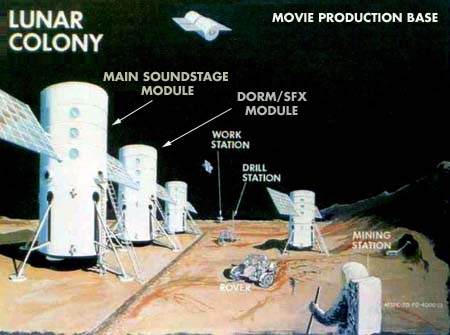 |
 |
|
|
 |
| by Jason Torchinsky |
Confirming what for years had been only a persistent rumor, undercover VGG reporters have determined that the July 1969 Apollo-program moon landings were indeed an elaborate government deception.
Immediately after President Kennedy's bold challenge to land an American on the moon before the end of the decade, NASA scientists and engineers began a crash program of assuming that the actual plausibility of landing on the moon was all but impossible. A program to create a hightly realistic simulated landing for public viewing was then begun in earnest, beginning with a series of unmanned Surveyor probes to get highly detailed views of the lunar surface for accurate soundstage production.
|
 |
Once the soundstages were built, it was found that accurately simulating the 1/6th gravity environment of the moon would be impossible. Many methods were tried, including trampolines, wires, and filming underwater, but nothing was found to have the realism required to pull the hoax off effectively. After numerous feasibility studies were carried out, it was decided to relocate the entire soundstage and all associated production facilities to the lunar surface to take advantage of the 1/6th gravity environment.
|
 |
Using top-secret heavy lift Titan VIII boosters from the air force, the main soundstage was placed in a pressurized space station cylinder module and launched into a parking orbit around the earth. Then, utilizing a series of Delta and Atlas launches, a large, multimodule Lunar Ship was constructed in orbit. The final piece, a powerful nuclear propulsion module, launched the orbital complex into a lunar orbit.
Once in lunar orbit, the complex was guided to a soft landing on the moon, where the crew of 75 began reconfiguring the ship's modules into a sophisticated film production studio. The Main Soundstage Module is the centerpice of the Lunar Movie Production Base, which also contains a dormitory for the crew to live in, a special effects module, a solar and nuclear power generating station, as well as smaller modules for the writers to use privately.
In the main soundstage a repilica of the Sea of Tranquility was built, and this is where actors playing Neil Armstrong and Buzz Aldrin (who was actually played by a woman, Saturday Night Live alumnus Nora Dunn) pretended to take man's first steps on the moon. The carefully orchestrated simulated landing was a far cry from the chaotic bustle of the lunar construction projects that made it all possible.
|
|
An interesting fact is that the decision to keep the Apollo 13 mission from landing the moon was so that there would be time to settle a strike of Film Editors and Teamsters on the lunar base.
|
 |
After Apollo 17, the usefulness for the top-secret film studio was up for debate. In an effort to keep the base operational, members of the original construction crew (crews were traditionally rotated every two years, and the base now bosted a complement of 125 men and women) sucessfully lobbied to keep the base open to suitable commercial customers. For example, all the underwater scenes from The Abyss were filmed in the low-gravity lunar environment, saving the expense of actual underwater filming. Also, movies such as The Matrix, Get Shorty, and Eyes Wide Shut all had significant scenes shot in the Lunar Studio (Now a part of Sony Pictures) for various reasons.
|
|
 |
 |